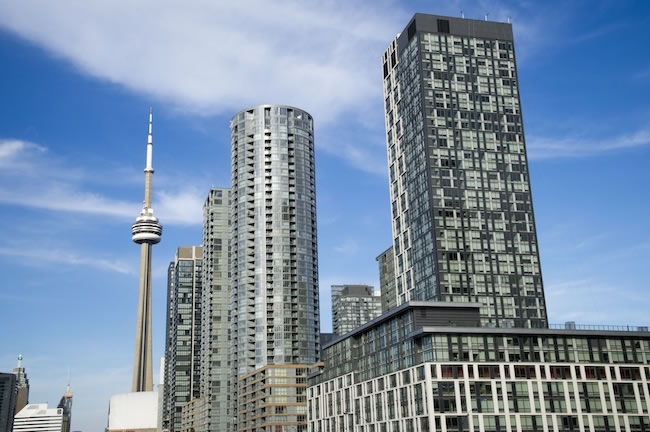The more electricity you use, the higher your electric bill. The more gas you consume, the higher your gas bill. Why should waste disposal be any different? That’s a question Toronto city officials were asking as far back as 2003, when, at its peak, the city was delivering 142 truckloads of garbage a day to the Carlton Farms Landfill in Michigan. That’s well over half a million tons a year. Not exactly the kind of international trade a city wants to be known for.
7,100
The number of communities in the U.S. using some type of PayT.
30
The number of the 100 largest U.S. cities that use PayT.
25%
Chunk of American citizens with access to PayT.
6.5m
The amount of municipal solid waste in tons, diverted per year thanks to PayT.
But, there was a plan. Beginning on January 1, 2011, all of Toronto’s waste requiring landfill disposal— about 874,131 tons annually—was to go to the Green Lane Landfill, located in Southwold Township southwest of London, about 124 miles from downtown Toronto. But even Green Lane had a life expectancy of 17 to 28 years, and the real issue was finding a way to motivate residents to divert their waste to recycling and organic bins, where it could be reused or composted.
So, as part of their long-term waste management plan, Toronto began a volume-based waste disposal service, with the goal of boosting their residential waste diversion rate—42% in 2006—to 70%. After investigating similar services in cities such as Vancouver, San Jose, Seattle, and San Francisco, commonly called “Pay as You Throw” (PayT) programs, Toronto launched a waste disposal service that charges residents based on how much garbage they are generating.
Here’s the gist: recycling, Green Bin organics, yard waste, appliances, household hazardous waste, and bulk waste are collected at the curb for free. Four sizes of blue bins handle recycling: plastic bottles, egg cartons, junk mail, laundry detergent tubs, and the like. Green bins handle organics. The city takes a bunch of other materials at transfer stations. Grey bins for non-recyclable, non-organic stuff, however, come with a price. Residents can pay for one of four sizes, beginning with a one-bag bin at $8.71 per year, all the way up to the largest 4/12 bag bin at $281.45 per year (amounts here in USD). Throw away more garbage, you pay for it.

Four sizes of blue bins handle recycling in Toronto: plastic bottles, egg cartons, junk mail, laundry detergent tubs, and the like. Other colored bins tackle organics, yard waste, trash, etc.
Across the United States and Canada, as landfills fill up and close, as tipping fees increase, and as growing concerns about carbon emissions make incineration a less attractive option, more and more cities are initiating some version of PayT. In fact, a 2006 U.S. Environmental Protection Agency report found that approximately 7,100 communities in the United States use some kind of PayT, including 30 of the 100 largest cities, making it available to approximately 25% of the country’s population.
According to the EPA’s report, PayT programs have had a huge impact on diversion—reducing residential disposal by about 17%, leading to the diversion of 6.5 million tons of municipal solid waste per year, and contributing to annual reductions of 2.1 to 3.8 million metric tonnes of carbon equivalents that would otherwise accelerate the pace of climate change.
PayT programs also have had a significant financial impact. San Jose, a city of nearly one million people, started a PayT program in 1993 known as Recycling Plus. Through “front-end” curbside diversion on the part of conscientious citizens, lucrative contracts with private recycling and composting companies, and “back-end” sorting at material recycling facilities, the city has reduced its annual disposal costs by more than $4 million dollars a year.
One of the things that sets Toronto’s program apart is a robust public education effort that makes clear to residents where their garbage actually belongs—and how they can save money by diverting it. “Our main tool that is the bible for how to recycle and divert waste is an annual calendar for every family. It tells you when garbage day is and how to divert it. We also have an online Waste Wizard, where you can type in an item for collection and learn which bin it goes in, along with a 311 service that you can call for instructions,” says Beth Goodger, manager of Solid Waste with the City of Toronto.
Most garbage, as it turns out, is not actually garbage. The average Toronto single-family household dumps about 440 pounds per year. City curbside audits show that two-thirds of this can be diverted: 38% is organic waste, 15% is recyclable, 2% is electronics, 3% is yard waste, and so on. Basically, people throw away things they shouldn’t because they don’t know any better or because, until recently, there was little incentive to take the time to sort it out.
So is Toronto’s program working? In short, yes. A total of 484,159 tons of residential waste was diverted from landfill in 2013, and the city reports a 53% waste diversion rate in 2014, not yet at the 70% target but moving in the right direction. “It is putting individual accountability in the hands of residents so they can make choices, while increasing their awareness about environmental impact. Council’s support for these programs has been a key for setting high diversion targets and recognizing waste as utility,” Goodger says.

